“Everybody has a plan to save the Middle East. That guy with the bumper sticker does. Most of your friends do. Neocons have a plan. Peaceniks have a plan. Likudniks have a plan. The Bush Administration certainly thinks it has one, and we’re told the Democrats are working on theirs. Tom Clancy imagined deploying the Vatican’s Swiss Guards to keep peace on the Temple Mount. Oakland Raiders owner Al Davis told the Contra Costa Times in July that he knew how to fix the situation—but he kept the details to himself. The policy debate resembles my family’s Thanksgiving dinner conversation after I knock a glass of red wine onto my mother’s white tablecloth: everybody has an idea about how to fix it, everybody is eager to share their thoughts, many ideas sound superficially plausible, and it’s difficult to distinguish among competing solutions.”
– PolicyMatters.net
Buenos Aires – I vaguely remember some famous statesman being quoted once to the effect that most international conflicts, in the end, are settled over dinner – i.e., at some point, the conflicting sides have to sit down at the table and have a conversation – and its usually eased by having food on the table. I can’t find the quote, and I don’t remember who said it, but it makes sense to me. Now, of course, there’ve been many dinners, both big public affairs, and probably a good number of small, intimate private ones, aimed at solving the “crisis” in the Middle East. Clearly, they haven’t served the right menu yet. No guarantees that we did either, nor was it really our intent, but given my recent series of classes in the cooking of the region, which, in answer to the folks who’ve been inquiring as to “whatever possessed you to take a class at the Club Sirio?”, came about because I really like the cuisine of the area, and I recently acquired a copy of Aromas of Aleppo: The Legendary Cuisine of Syrian Jews by Poopa Dweck. Oy, I feel for her – I mean, not to put too fine a point on it, and no doubt where she grew up in Aleppo, Syria her name didn’t cause much commentary, but I have no doubt that in Deal, New Jersey, where she lives now, it just might…
My point, however, is that “middle eastern” or “arab” cooking doesn’t mean “islamic jihad” and suicide bombers blowing up hors d’oeuvres. The region encompasses muslims, jews, christians, and probably the odd hindu or buddhist; and a dozen and a half countries, many of which are locked in various “other” conflicts, or not – Egypt, Israel, Jordan, Lebanon, Syria, Saudi Arabia, Yemen, Oman, UAE, Qatar, Bahrain, Iran, Iraq, Azerbaijan, Armenia, Georgia, Turkey, and Cyprus… there was lots of play room. On to the food, which was drawn from ideas garnered in the class, the aforementioned book, a couple of others that I already had, and a few ideas thrown in passively by the internet.
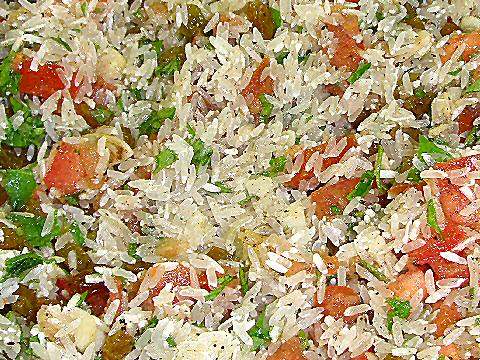
We made stuffed grape leaves in class… or watched them being made anyway. Traditional meat and rice filling and all that, and someone in class piped up with “what about vegetarians?” Well, while he didn’t have a recipe to hand out, Chef Abdala threw back a sort of “hmm… well, there’s this really delicious, cool filling you could make from: rice, almonds, golden raisins, tomato, cilantro, cardamom, baharat, coffee, and olive oil…” He left it at that and moved on, but I scribbled it down thinking it sounded interesting… First off, “baharat”? He referred to it a few times during classes, but passed it off as “a mix of spices, don’t worry about it, you can use allspice”. Interesting, as it turns out, and in fact, Poopa, our erstwhile author, uses allspice throughout her recipes – I wonder if its because baharat is hard to find in central NJ? The mixture, as it turns out, is readily available in middle eastern markets here – and looking it up it’s a blend of nutmeg, black pepper, coriander, cumin, cloves, cinnamon, cardamom, paprika, and chili powder. To me, it doesn’t taste anything like allspice. Oh, and wait, coffee? Yup, he assured us on being questioned, that some freshly ground coffee in the mixture was a good thing – okay then. I winged it, as I generally do, and came up with this filling – note that the rice is raw – it’s just rinsed briefly in cold water…
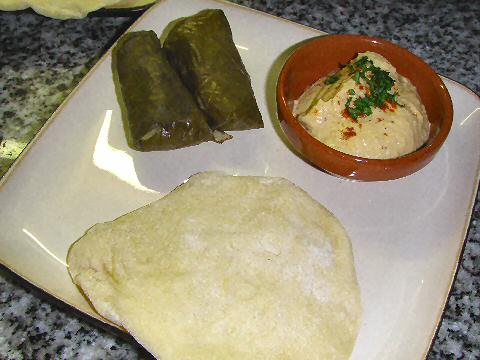
… and then about a heaping teaspoonful went into each grape leaf, then I rolled them up – being careful not to overfill them, nor roll them too tightly – remember, the rice is going to swell up to nearly three times its size when it’s cooked. I like the method of cooking them too – line a pot with slices of tomato, then put the grape leaf packets in a ring, side by side, around the outer edge, wedged in pretty well together. Then fill the center with vegetable stock and a few crushed garlic cloves, put a heavy plate in to hold them in place and under the liquid, bring the pot to a simmer and cook for about 40 minutes. I served these cold, but they’re good hot as well. Alongside, a take on the Aleppo version of hummus, bringing in a bit of Turkish flavor – I made a blend of chickpeas (just cooked, and the skins removed – not canned, though I’ve tried that and it works well for this recipe too), olive oil, salt, lemon juice, tahini (sesame paste), garlic, cumin, and in place of Aleppo pepper, which as far as I know isn’t available here, I used some urfa-biber, a mildly spicy smoked Turkish pepper that I picked up a package of on my last trip to NY. Given that we hadn’t covered pita bread in class, I decided to defer to the internet and a recipe that, as assured, works out “perfectly”.
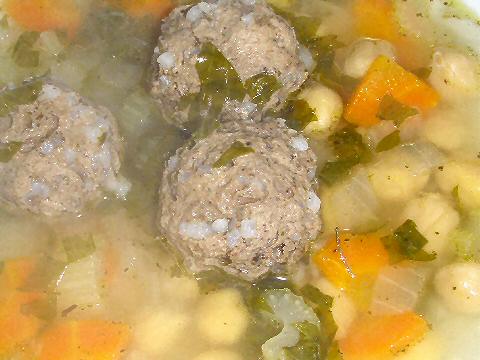
Sticking with the book for a moment, though combining two different recipes, a simple vegetable soup (celery, carrots, chickpeas (hmm, that was my addition, not in the original recipe, but I cooked too much for the hummus…), garlic) and flavoring it with lemon (juice and grated rind) and mint, and then meatballs made of ground beef (better to grind you’re own…) with some dry rice, baharat, cinnamon, and salt mixed in. Packed tightly into small meatballs and then simply dropped in the simmering soup and left to cook until the rice is done. Delicious! I loved the combination of flavors in this one, and it drew a couple of rave comments from guests.
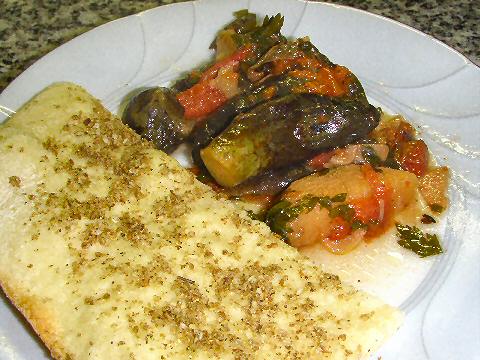
This is my own twist on a couple of different dishes from different places. Traditionally, small eggplants are hollowed out and filled with a meat or vegetable stuffing, then layered with quince in a pot, cooked slowly for a couple of hours in the oven in a bit of stock, and then served topped with candied quince. I took out the latter as too sweet, but I got to this recipe because quinces and baby eggplant are in the markets this last week or two. I decided to simply braise them together with the spices that would normally have gone into the meat filling, just without the meat. So into a pot went the cleaned and destemmed baby eggplant, then I topped those with slices of quince, tomato, and white onion. Seasoned with good amounts of mint, allspice, cinnamon, garlic, some sugar and salt, olive oil, the juice of a lemon, and some pomegranate molasses. I covered it and cooked it slowly for a couple of hours, and it comes out great! Since I was playing with some spice mixture ideas, I spotted an Egyptian one called dukka, which I modified only in leaving out yet more chickpeas, and simply made a mix of sesame, coriander, cumin, thyme, mint, and salt, and then a quick flatbread that I rolled out really thin, topped with the spice mixture, and baked until it was chewy with just crispy edges.
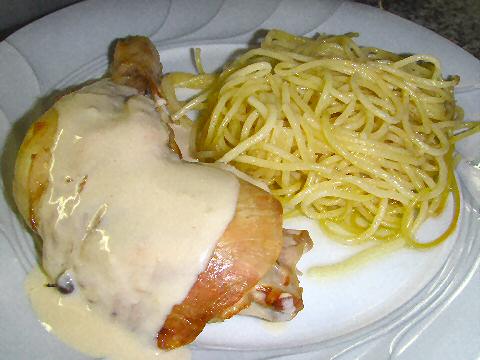
Okay, not thrilled with the presentation, thrilled with the flavor. I’ll work on the former. The chicken leg/thigh combination skinned (save the skin, preferably in one big piece), and then marinated for about ten hours in a shawarma marinade – very typical throughout Israel, Lebanon, Jordan – white wine, vinegar, lemon, dried chili peppers, allspice, salt (all blended together) – and then quickly sauteed in a pan just to lightly brown the outside. Meanwhile, I cooked some spaghetti until it was just barely al dente – you want this on the undercooked side. Tossed it with some olive oil and then put it into little casserole dishes line with the chicken skin (for flavoring and to help brown the spaghetti a little was the idea, turns out it prevented the latter but added a whole lot to the former). Set a chicken piece atop each little casserole and into the oven to finish cooking, letting the meat juices drip into the spaghetti, which does crisp up a little bit, but not as much as I was hoping for. Flipped the spaghetti out onto the plate aside the chicken, removed the piece of chicken skin, and voila. At the very least it needs to be sprinkled with a little chopped parsley, no?
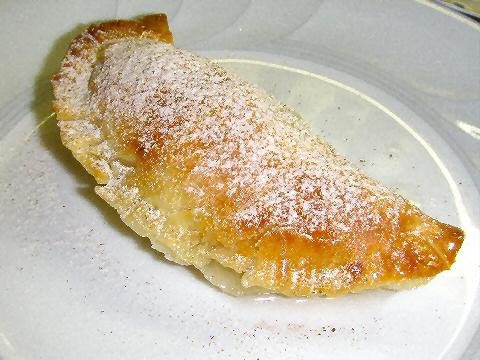
Taking off from a traditional dessert that involves little mini-empanadas filled with plain ricotta, then deep fried, and soaked in syrup and then served cold. I decided to go with a full sized empanada filled with our homemade ricotta that I’d sweetened a bit and added raisins and walnuts to. I baked them instead of deep frying them, then soaked them in a syrup made from sugar, water, lemon, cinnamon, cloves, and orange blossom water (pretty much right out of the class), topped them with a mix of cinnamon and sugar and served them up hot. They’re also really good the next day, cold, with coffee in the morning… trust me.
So, our little contribution to middle eastern multi-culturalism. To the best of my knowledge, no one attended who’s going to have much say in the solving of any conflicts in that part of the world, but, hey, you never know…
Hi Dan,
Reading your post on Middle Eastern food and in particular the part about the stuffed grape leaves & “baharat”, I couldn’t help but leave a comment.
As for the vegetarian version of the stuffed grape leaves, it is a popular dish here in Turkey, as popular as the meaty version, but as opposed to the meaty version, eaten as an appetizer (and always cold). It is like the Greek “dolmades” (Turkish is called dolma, literally meaning stuffed in Turkish, or “sarma”, meaning “rolled up”), though our version is sweeter – spicier and and not eaten with the Greek avgolemono sauce but just with some freshly squeezed lemon juice. The filling is different than yours as well, and can be used to stuff all kinds of vegetables (green peppers are next to grape leaves in popularity, followed by eggplant and white cabbage). Your filling sounds like a more savours one, the Turkish version is somewhat sweeter. Rice is one of the maind ingredienst naturally, but the second one is onion, actually you have to use quite a lot (and I mean a lot, for a middle sized pot of dolmas you use 5-6 middle sized onions!), the sweetish taste is given by the onions, slowly baked until they release all their sugar. The complete filling, including the rice, is pre-cooked, rice is added to the onions after they are nicely browned, together with some water, pine nuts, raisins (very small black ones, I don’t know their name in English, or if they would be available there) and a different mixture of “baharat”. Our version tastes more like cinnamon and allspice and is called “dolma bahari”. There is another one used for meatballs, called “kofte bahari” and it is more like the baharat you have described. Baharat is actually a general name for spice in Turkey, “bahar” meaning spring, the word (which itself is Arabic) must be related to nice fragrances.
Your version also sounds delicious by the way, I should try it some time. It sounds like a fresher tasting recipe, with the addition of cardemom and cilantro, both of which I love and use a lot! Cilantro is unfortunately not used at all in Turkey and many people hate it, until a few years ago you could not even find it anywhere, luckily these days some grocers sell it, though at a criminal price!
Aaahhh I got so hungry writing all this and reading your menu 🙂
I’m also not sure that the baharat that I bought here at one of the middle eastern markets was the blend I described above. It was simply what they had and what they offered when I asked for some. It, like the one you mention, seems much more on the “sweet spices” side of things – if there’s any chili or black pepper in it, it’s minimal. Next time, I think I’ll try grinding my own just to see how it comes out!
It’s interesting, too, on the rice mixture – I had made the Greek ones before, and had always cooked the rice before stuffing the grape leaves. So I was surprised when I saw the method of doing it without – it would seem like if you really sealed them well, the rice wouldn’t absorb enough liquid to cook. But, it does, leaves being porous and it not truly being sealed. They also seem to end up firmer this way – with precooked rice, the firmness of the rolled packages is pretty much a function of how well you roll them. This way, the rice expands to fill every nook and cranny, and makes a very nice, tight package.
The meaty version of the stuffed vegetables are made with uncooked rice, like yours, and the rice indeed gets cooked and stays firmer. I don’t know why but somehow the cold vegetarian version is liked much better when it is soft, almost mushy, actually getting it mushy is kind of unavoidable with a pre-cooked rice mixture. Mushiness is not really a positive quality but most people would dislike their vegeratian dolmas – sarmas if they are firmer. I guess it is just something they are used to from childhood, without having ever questioned it. After all, this is one of the most traditional dishes and in traditional Turkish and Greek dishes almost everything is overcooked…which is not always a bad thing though, the vegetables that are slooooow cooked over very soft fire with olive oil (and again lots of onion, it is a rule for these cold eaten dishes cooked in olive oil) can be really tasty, with all the flavours merged and melting in the mouth.
Oh, I meant to ask yesterday and forgot by the way, what is the sauce on the chicken?
Ahh, I forgot about the sauce – it’s called (at least here) salsa tartura, it’s a blend of 1 cup of tahini, ½ cup of lemon juice, just enough water to smooth it out as it blends, and then salt to taste. Garlic is optional, and I didn’t put it in this version, but a touch of garlic is quite good in it. Same sauce that’s usually put on falafel, or on classic shawarma.
Maybe it’s just me but the ‘baharat’ you used reminds of the ‘garam masala’ we often make at home in India.
There are definitely close similarities. Classic garam masala is a mix of cinnamon, bay leaf, cumin, coriander, cardamom, black peppercorns, cloves, and mace – so you can see that most of the ingredients are the same, though, in quite different proportions, the only big difference is baharat contains a large amount of paprika, plus ground hot chilies, and obviously for a spicy version of garam masala it’s not unusual to add the latter.
[…] talked before about how to make stuffed grape leaves, these follow the same process, just with a different filling. I sauteed diced oyster mushrooms and […]
[…] grape leaves, veggie style, in and of themselves, not a new version but my tried and true one. The change, a Taratur Sauce – tahini (sesame paste), lemon, salt, and enough water to thin […]
anyone knows the recipe for kofte bahar ?
ingredients & dosage ?
I can’t help you with the Turkish kofte bahari that Sila mentioned, but, the baharat that I make when I make my own is a ground mix (best to grind from whole spices, but it will work with pre-ground ones) of:
1½ teaspoons nutmeg
1 teaspoon black pepper
1 teaspoon coriander
1 teaspoon cumin
1 teaspoon clove
¼ cinnamon stick (1/8 teaspoon ground)
seeds from 2 green cardamom pods (1/3 teaspoon ground)
2 teaspoons hot paprika
½ teaspoon dried chili
[…] Greece to the Middle East, in this case, with minor spicing changes, the same as one we did for our Syrian dinner a year and a half ago, and served up with a soured cream and fresh herb sauce. The wine, from Santa […]